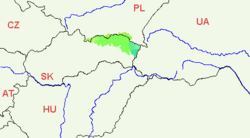West Carpathian
| West Carpathian language | |
|---|---|
| Kārpāthirēta | |
 | |
| Pronunciation | [/ˈkaːr.paː.ɦi.ˈreː.tɑ/] |
| Created by | Raistas |
| Setting | parallel Earth |
| Ethnicity | Carpathian people |
| Native speakers | 45 0000 (2012 census) |
Oronaic
| |
Early forms | Proto-Oronaic
|
West Carpathian (native name - kārpāthirēta) is one of the three recognized Carpathian languages spoken by the Carpathian people in Slovakia and in three small mountainous regions of Southern Poland. It has approximately 45 000 native speakers according to 2012 census in Slovakia (including speakers of dialects).
West Capathian was influenced by West Slavic languages, Polish and Slovak in particular, and also by hungarian to a lesser extend. Typologically it is between fusional and agglutinative languages and is different from surrounding Indo-European languages. It has a complex inflection system for nouns, adjectives, pronouns, numerals and verbs, depending on their roles in the sentence.
History
Ancient history
The Proto-Carpathian is believed to have formed near Polish-Slovak border near 2500 BCE, after its split from hypothetical Proto-Alpathian or directly from Proto-Oronaic itself with an intermediate stage as a proto-dialect. According to most linguists, the language comes from Polish lowlands in the basin of Vistula river. Current models assume two or more hypothetical Pre-Proto-Carpathian dialects evolving over the first millennium BCE. This data is supported by Ancient Roman geographers and writers, such as Ptolemy and Marinus of Tyre, who mentioned the Estri tribe, which inhabited modern day Lower Austria, and the city of Esterixus, located somewhere in modern Bezirk Lienz. There are very few language examples, which is not enough to determine, whether Estrian was an early Carpathian language. Some scholars agree that it could possibly be an ancient Alpian language or even Proto-Alpian, while those, who support Proto-Alpathian existence, claim it to be an intermediate language between Alpian and Carpathian.
Medieval period
The first attestation of West Carpathian was on the XVth century map of Eastern Europe. The words are "Kárpathiáte" (modern spelling - kārpāttāt, which means "Carpathians' land"). More written records were found also in the form of personal names and short notes. In the late XVIIth century the Bible was translated by Josef Kauffman. However, only the first few pages remain to these days, while the rest of the book is lost and it is not known, if this was a complete translation, since there were no copies of the book. Other attempts to translate any texts into West Carpathian were abandoned. All liturgical ceremonies were held in Latin
Standardization
The first comprehensive writing system for West Carpathian was created by Jan Meyer in the 1878, which was based on Czech orthograpy. He also wrote some linguistic works about West Carpathian, using his writing system to write words and sentences in Carpathian. His written language was based on westernmost dialects and he wanted to represent one sound with one letter, exept for a few digraphs, like "ch" for [x] or [h], "th" for [θ] and "dh" for [ð̞]. In the early XXth century Jan Meyer's work was revised and new writing systems were proposed, in one of which long vowels were represented with a macron above a vowel letter instead of acute.
Modern period
Up until Jan Meyer written Carpathian was used solely in religious texts, but after his works the language slowly started appearing in newspapers and literature. In 1961 Bohuslav Raudi (native name Eiki) created a new standard writing for both West and East Carpathian, based on previuos systems. He attemted to unify different dialects into a Carpathian language and his writing system became standard written West Carpathian. He also retained the "th" digraph as it was in Jan Meyer's system, despite [θ] sound was no longer present in any Carpathian dialect; and changed "dh" into plain "d", as "d" only appeared in this digraph and proper names due to absent of [d] sound. His daughters Anna and Maria Raudi created a complete West Carpathian-Slovak dictionary in 1989 together with other scholars as well as workbooks for everyone to learn their language. They also wrote dozens of articles about various Carpathian dialects.
Phonology
Morphology
Dialects
Geographic distribution
West Carpathian is spoken by about 45 thousand people, most of whom are Slovakian citizens. There are also small Carpathian minorities in Poland (less than 7 000 people). The majority of the Carpathian population in Slovakia, 78% as of 2012, speak West Carpathian as their first language, while in Poland this number is significantly smaller (19%, which is approximately 2000 speakers).
Official status
West Carpathian is a minority language in Slovakia and has a status of a regional language in Žilina and Prešov regions. In some municipalities of Bytča, Čadca, Námestovo, Bardejov, Svidník, Medzilaborce and Snina districts it is co-official with Slovakian.